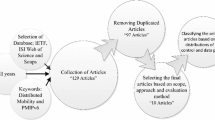Abstract
In IEEE 802.16e mobile Worldwide Interoperability for Microwave Access (WiMAX), paging groups (PGs; groups of base stations) are used to identify the locations of mobile stations (MSs). An anchor paging controller (APC) is assigned to an MS to handle location tracking for the MS. During location update, the WiMAX network may or may not relocate the APC. This paper considers a linear WiMAX base station layout for vehicle applications, where a base station serves as a roadside unit, and a WiMAX MS installed in a vehicle serves as an onboard unit. In these vehicle applications, APC relocation may significantly affect the network traffic. This paper proposes an analytic model to study the performance of the location update with/without APC relocation. Our study provides guidelines to utilize the APC relocation for vehicles with various moving behaviors.







Similar content being viewed by others
References
Haas Z, Lin Y-B (2000) Demand re-registration for PCS database restoration. Mob Netw Appl 5(3):191–198
IEEE (2006) Family of standards for wireless access in vehicular environments (WAVE). IEEE 1609
IEEE (2007) Draft amendement to part 11: wireless medium access control (MAC) and physical layer (PHY) specifications: wireless access in vehicular environments (WAVE). IEEE Std 802.11p/D2.01
Johnson D, Perkins C, Arkko J (2004) IP mobility support for IPv6. IETF RFC 3775
Lin Y-B (2008) M-Taiwan: a WiMAX experience, keynote speech. In: The international conference on mobile technology, applications and systems (mobility conference), YiLan. http://www.mobilityconference.org/go/programme/keynote/
Masini BM, Zuliani L, Andrisano O (2006) On the effectiveness of a GPRS based intelligent transportation system in a realistic scenario. In: IEEE 63rd vehicular technology conference (VTC 2006—Spring)
Ross SM (1996) Stochastic processes, 2nd edn. Wiley, New York
Tsai M-H, Lin Y-B (2007) Eavesdropping through mobile phone. IEEE Trans Veh Technol 56(6):3596–3600
WiMAX Forum (2007) WiMAX end-to-end network systems architecture (stage 2: architecture tenets, reference model and reference points). NWG stage 2 - Release 1.1.0
WiMAX Forum (2007) WiMAX forum network architecture (stage 3: detailed protocols and procedures). NWG stage 3 - Release 1.0.0
WiMAX Forum (2007) WiMAX forum network architecture (stage 3: detailed protocols and procedures). NWG stage 3 - Release 1.1.0
Yang S-R (2007) Dynamic power saving mechanism for 3G UMTS system. Mob Netw Appl (MONET) 12(1):5–14
Zang Y-P, Weiss E, Stibor L, Chen H, Cheng X (2007) Opportunistic wireless internet access in vehicular environments using enhanced WAVE devices. In: Internation conference on future generation communication and networking (FGCN), vol 1, pp 447–452
Acknowledgements
This work was sponsored in part by NSC 97-2221-E-009-143-MY3, NSC 97-2219-E009-016, Far Eastone Telecom, Chung Hwa Telecom, ICL/ITRI, ITRI/NCTU Joint Research Center and MoE ATU.
Author information
Authors and Affiliations
Corresponding author
Rights and permissions
About this article
Cite this article
Lin, YB., Lin, YC. WiMAX Location Update for Vehicle Applications. Mobile Netw Appl 15, 148–159 (2010). https://doi.org/10.1007/s11036-009-0171-8
Published:
Issue Date:
DOI: https://doi.org/10.1007/s11036-009-0171-8




